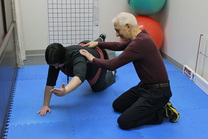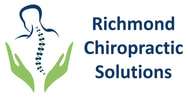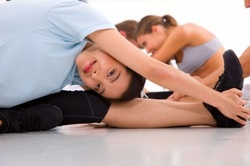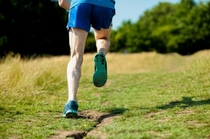
Strength and fitness:
Regular exercise programs help with hypermobility and chronic pain problems such as fibromyalgia, osteoarthritis and rheumatoid arthritis.
With hypermobility syndrome it's important to develop and maintain a good fitness program matching your individual needs. This should to take into account your tissue strength and ability to withstand acute and repetitive stress without sprains, strains, tendinitis or bursitis.
If you fall into one of the more severe categories, you have to consider your vascular strength which may include risk factors for cerebral and aortic aneurysm. Talk to your primary care physician regarding this.
Contact sports or any high impact activity can be damaging. At the same time you want to maximize the strength of your tissues from muscles and tendons to ligaments and bones density. Cardiovascular health needs to be included as well.
The program should be consistently followed to avoid back sliding and becoming discouraged as well as the difficulty and pain of restarting.
Developing proprioception (body awareness), balance, and reaction timing is critical for prevention of acute injuries and repetitive stress caused by poor coordination. Maintaining balance and control is important beyond simply not falling down and hurting yourself. This is where exercises such as tai chi and yoga can play a big part – not in training you to stretch further and cross your legs and a weird fashion, but to stand on one foot and remain in control as you shift your weight to the side or to the front. The more hypermobile you are the less proprioceptive input you have regarding your position in the world. If your position sense is not good it's easy to overstress joints. If you're not stable standing on one foot and your ankle is wobbling back and forth you have to ask, what is happening when you're walking?
Overstretching, as in some forms of yoga and weightlifting, frequently produce unwanted symptoms and risk decreasing motor control. Never stretch beyond the range that you would normally use.
Isometric exercise avoids hyperextension and some overuse issues while contributing to strength.
Try to use free weights, body weight and closed chain exercises as opposed to machines when possible. Choosing dumbbells rather than machines in the gym prepares you better for everyday life since they are like real objects and promote better control and stabilization. Use of low impact elliptical training machines can replace high-impact running.
Running a 5K may be a reasonable option for some whereas half marathons are probably a bad idea for anyone who is hypermobile. If you choose to run be certain that you can do it with perfect form all the way down from knees to controlling ankle pronation.
Recovery is a critical component of your program. This includes at least eight hours of sleep. It's best to use undulating periodization to maximize the rest intervals so that you aren't exercising the same muscle groups in the same way too frequently.
Exercising in the pool is a reasonable recovery option but you have to keep in mind that we operate on dry land most of the time and need to maintain competence there. It is also difficult to maintain weight using only pool exercise. Pain-free swimming may require a kickboard or extra care to avoid hyperextending elbow and other joints. Rotator cuff strength and scapular control are critical.
Lifestyle and ergonomic modification:
You need to protect yourself from impacts, move well, maintain excellent posture and be supported well by your furniture. Things that don't bother other people may bother you and things that don't feel uncomfortable to you may be very damaging to you.
Typing can reduce pain from writing. Alternating between different types of mice can help reduce wrist stress.
Voice control software or a more ergonomic keyboard can reduce pain from typing.
Bent knees or sitting can reduce pain from standing. Avoid shifting your hips forward into a swaybacked position.
Other treatments:
Chiropractors, massage therapists and physical therapists can be used as needed for specific circumstances.
It is counterintuitive to use treatments intended to increase mobility on a hypermobile person. The problem is you need your muscles to control the position of your joints but when painful they are unable to do a good job of this. Experienced massage therapists can help improve function.
When spinal joints are locked up and painful and you are unable to move properly you compensate and can overstretch other areas. Chiropractors and physical therapists can use gentle techniques including muscle energy techniques and mobilization to assist with this. They can also help you figure out your exercise plan and ergonomics.
A pain psychologist referral can be useful e.g. cognitive-behavioral therapy or other evidence-based care.
I highly recommend the following paper and have included some relevant selections below:
Regular exercise programs help with hypermobility and chronic pain problems such as fibromyalgia, osteoarthritis and rheumatoid arthritis.
With hypermobility syndrome it's important to develop and maintain a good fitness program matching your individual needs. This should to take into account your tissue strength and ability to withstand acute and repetitive stress without sprains, strains, tendinitis or bursitis.
If you fall into one of the more severe categories, you have to consider your vascular strength which may include risk factors for cerebral and aortic aneurysm. Talk to your primary care physician regarding this.
Contact sports or any high impact activity can be damaging. At the same time you want to maximize the strength of your tissues from muscles and tendons to ligaments and bones density. Cardiovascular health needs to be included as well.
The program should be consistently followed to avoid back sliding and becoming discouraged as well as the difficulty and pain of restarting.
Developing proprioception (body awareness), balance, and reaction timing is critical for prevention of acute injuries and repetitive stress caused by poor coordination. Maintaining balance and control is important beyond simply not falling down and hurting yourself. This is where exercises such as tai chi and yoga can play a big part – not in training you to stretch further and cross your legs and a weird fashion, but to stand on one foot and remain in control as you shift your weight to the side or to the front. The more hypermobile you are the less proprioceptive input you have regarding your position in the world. If your position sense is not good it's easy to overstress joints. If you're not stable standing on one foot and your ankle is wobbling back and forth you have to ask, what is happening when you're walking?
Overstretching, as in some forms of yoga and weightlifting, frequently produce unwanted symptoms and risk decreasing motor control. Never stretch beyond the range that you would normally use.
Isometric exercise avoids hyperextension and some overuse issues while contributing to strength.
Try to use free weights, body weight and closed chain exercises as opposed to machines when possible. Choosing dumbbells rather than machines in the gym prepares you better for everyday life since they are like real objects and promote better control and stabilization. Use of low impact elliptical training machines can replace high-impact running.
Running a 5K may be a reasonable option for some whereas half marathons are probably a bad idea for anyone who is hypermobile. If you choose to run be certain that you can do it with perfect form all the way down from knees to controlling ankle pronation.
Recovery is a critical component of your program. This includes at least eight hours of sleep. It's best to use undulating periodization to maximize the rest intervals so that you aren't exercising the same muscle groups in the same way too frequently.
Exercising in the pool is a reasonable recovery option but you have to keep in mind that we operate on dry land most of the time and need to maintain competence there. It is also difficult to maintain weight using only pool exercise. Pain-free swimming may require a kickboard or extra care to avoid hyperextending elbow and other joints. Rotator cuff strength and scapular control are critical.
Lifestyle and ergonomic modification:
You need to protect yourself from impacts, move well, maintain excellent posture and be supported well by your furniture. Things that don't bother other people may bother you and things that don't feel uncomfortable to you may be very damaging to you.
Typing can reduce pain from writing. Alternating between different types of mice can help reduce wrist stress.
Voice control software or a more ergonomic keyboard can reduce pain from typing.
Bent knees or sitting can reduce pain from standing. Avoid shifting your hips forward into a swaybacked position.
Other treatments:
Chiropractors, massage therapists and physical therapists can be used as needed for specific circumstances.
It is counterintuitive to use treatments intended to increase mobility on a hypermobile person. The problem is you need your muscles to control the position of your joints but when painful they are unable to do a good job of this. Experienced massage therapists can help improve function.
When spinal joints are locked up and painful and you are unable to move properly you compensate and can overstretch other areas. Chiropractors and physical therapists can use gentle techniques including muscle energy techniques and mobilization to assist with this. They can also help you figure out your exercise plan and ergonomics.
A pain psychologist referral can be useful e.g. cognitive-behavioral therapy or other evidence-based care.
I highly recommend the following paper and have included some relevant selections below:




 RSS Feed
RSS Feed